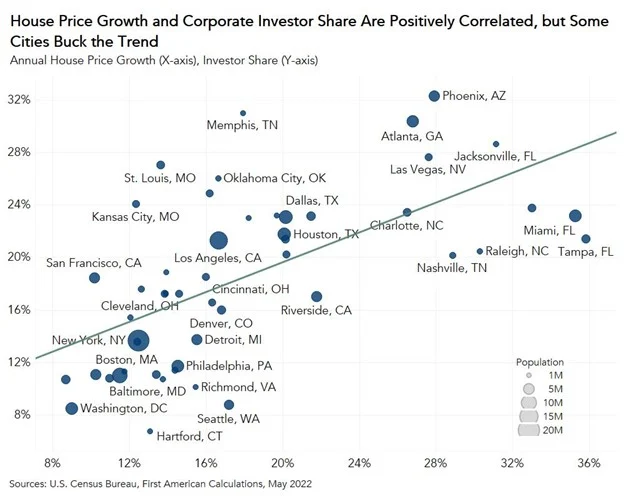 Citing recent data from First American Data & Analytics, investor purchases of residential homes as rental properties as a share of all residential home sales, have increased sharply over the course of the last year.
Citing recent data from First American Data & Analytics, investor purchases of residential homes as rental properties as a share of all residential home sales, have increased sharply over the course of the last year.
This number has risen from 10.5% in May 2021 to 18% by May 2022.
According to Xander Snyder, the Senior Commercial Real Estate Economist for First American, increasing investor participation in the residential housing market has coincided with remarkable growth in the house prices, leading some to attribute the worsening housing affordability crisis to the increase in investor participation.
An alternative explanation of this phenomenon is that rapid house price appreciation caused greater investor participation in this segment of the market.
So, which came first?
“It turns out, as one might expect, that house price growth and investor participation are positively correlated,” Snyder said in a blog post. “While there is substantial variation from city to city, we found cities with a larger investor share of sales generally experienced greater house price growth over the last year.”
“For example, Phoenix, Atlanta and Jacksonville had the largest investor share in May as well as some of the fastest year-over- year house price growth rates in the country.”

The top five cities by investor share in May 2022 were:
Phoenix
- Investor share: 32%
- Annual house price growth: 28%
Memphis, Tennessee
- Investor share: 31%
- Annual house price growth: 18%
Atlanta
- Investor share: 30%
- Annual house price growth: 27%
Jacksonville, Florida
- Investor share: 29%
- Annual house price growth: 31%
Las Vegas
- Investor share: 28%
- Annual house price growth: 28%
But Snyder wars that correlation is not causation, as the saying goes.
“Investor purchases could be driving price appreciation, or it could be the other way around, or both. There could also be a third factor driving both the growing investor share of purchases and house price appreciation simultaneously—a pandemic-driven surge in housing demand against a limited supply of homes for sale. It’s difficult to know with a high degree of certainty, but recent history provides some insight.”
Pandemic-priced properties?
The rise in home demand has largely stemmed from “pandemic-induced flight” migrations away from urban centers as more workers took advantage of remote working opportunities to leave for the less populated suburbs. This migration caused record house price appreciation, which in turn is now high enough that people are becoming priced-out of the purchase market forcing them into renting—which is experiencing its own problems as rent itself grew at a record-setting pace over the same period.
The confluence of furious rent growth house price appreciation flushed even more investors rife with fresh capital to bring to the market.
Snyder notes that this explanation is “compelling” due to the fact that annual house price growth was already in the double-digit range before investors began to flood the market in the second half of 2021.
“In other words,” Snyder said, “there’s a strong case to be made that house price growth was influential in driving up the investor share.”
Compounding this increase was the lack of inventory, which further pushed up prices. By some estimates, the market shortage now hovers around 3.8 million units.
Permanent phenomenon or a passing phase?
“If greater investor participation continues to contribute to elevated demand relative to limited supply, then house prices are likely to remain positive despite rising interest rates,” Snyder said. “If house price growth is enticing greater investor participation, then we would expect to see declining investor participation in the residential housing market as house prices decelerate.”
“Currently, investor participation remains near all-time highs, but mortgage purchase applications were down 16% year-over-year in a late-July report, indicating a declining buyer pool for potential homes that may translate to slower price growth in the near term.”
“However, the ongoing housing shortage will continue to make home prices particularly responsive to changes in demand. So, which came first, greater investor participation or faster house price growth? Perhaps, neither,” Snyder concluded. “It seems that both were predated by pandemic-accelerated demand amid a historic supply shortage.”

 DSNews The homepage of the servicing industry
DSNews The homepage of the servicing industry









